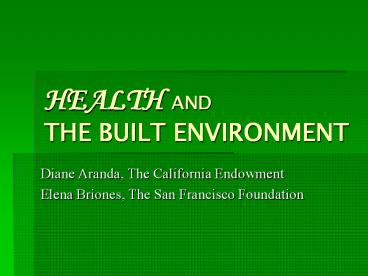HEALTH AND THE BUILT ENVIRONMENT - PowerPoint PPT Presentation
1 / 40
Title:
HEALTH AND THE BUILT ENVIRONMENT
Description:
Deepen understanding of the built environment and its connection to health ... See 'Heat Wave: A Social Autopsy of Disaster in Chicago by Eric Klinenberg (or ... – PowerPoint PPT presentation
Number of Views:696
Avg rating:3.0/5.0
Title: HEALTH AND THE BUILT ENVIRONMENT
1
HEALTH AND THE BUILT ENVIRONMENT
- Diane Aranda, The California Endowment
- Elena Briones, The San Francisco Foundation
2
Goals for Today
- Deepen understanding of the built environment and
its connection to health - Showcase how communities are working to improve
the built environment and community health - Share challenges and opportunities for funding in
this arena
3
The Built Environment
- All aspects of our surroundings that are
constructed by people buildings, roads, parks
and so on
4
Buildings
5
Roads and public transportation systems
6
Parks and Green Space
Marin Co
7
How we plan and design our cities
8
and our neighborhoods
9
Why does the Built Environment matter?
- The Built Environment directly and indirectly
affects human health and the natural environment. - The diseases of the 21st century will be chronic
diseases, those that steal vitality and
productivity, and consume time and money. These
diseases-heart disease, diabetes, obesity,
asthma, and depression-are diseases that can be
moderated by how we design and build our human
environment. - -Richard J. Jackson, MD, MPH
10
Cause of Death, California, 2003
- All Causes Percent of Total
Deaths - Diseases of heart 28.8
- Malignant neoplasms 22.7
- Cerebrovascular diseases 7.4
- Chronic lower respiratory diseases 5.6
- Accidents (unintentional injuries) 4.4
- Influenza and pneumonia 3.4
- Diabetes mellitus 3.0
- Alzheimers disease 2.8
- Chronic liver disease and cirrhosis 1.6
- Intentional self-harm (suicide) 1.4
- Source CDC/NCHS, National Vital Statistics System
11
Leading vs Actual Causes of Death
12
(No Transcript)
13
(No Transcript)
14
(No Transcript)
15
(No Transcript)
16
Diet and activity
17
Actual Causes of Death
- are defined as lifestyle and behavioral factors
such as smoking and physical inactivity that
contribute to this nations leading killers
including heart disease, cancer and stroke.
18
Obesity Trends Among U.S. AdultsBRFSS, 1985
(BMI 30, or 30 lbs overweight for 5 4
person)
No Data lt10 1014
19
Obesity Trends Among U.S. AdultsBRFSS, 1990
(BMI 30, or 30 lbs overweight for 5 4
person)
No Data lt10 1014
20
Obesity Trends Among U.S. AdultsBRFSS, 1995
(BMI 30, or 30 lbs overweight for 5 4
person)
No Data lt10 1014
1519
21
Obesity Trends Among U.S. AdultsBRFSS, 1996
(BMI 30, or 30 lbs overweight for 5 4
person)
No Data lt10 1014
1519
22
Obesity Trends Among U.S. AdultsBRFSS, 1997
(BMI 30, or 30 lbs overweight for 5 4
person)
No Data lt10 1014
1519 20
23
Obesity Trends Among U.S. AdultsBRFSS, 1998
(BMI 30, or 30 lbs overweight for 5 4
person)
No Data lt10 1014
1519 20
24
Obesity Trends Among U.S. AdultsBRFSS, 1999
(BMI 30, or 30 lbs overweight for 5 4
person)
No Data lt10 1014
1519 20
25
Obesity Trends Among U.S. AdultsBRFSS, 2000
(BMI 30, or 30 lbs overweight for 5 4
person)
No Data lt10 1014
1519 20
26
Obesity Trends Among U.S. AdultsBRFSS, 2001
(BMI 30, or 30 lbs overweight for 5 4
person)
No Data lt10 1014
1519 2024 25
27
Obesity Trends Among U.S. AdultsBRFSS, 2002
(BMI 30, or 30 lbs overweight for 5 4
person)
No Data lt10 1014
1519 2024 25
28
Obesity Trends Among U.S. AdultsBRFSS, 2003
(BMI 30, or 30 lbs overweight for 5 4
person)
No Data lt10 1014
1519 2024 25
29
Obesity Trends Among U.S. AdultsBRFSS, 2004
(BMI 30, or 30 lbs overweight for 5 4
person)
No Data lt10 1014
1519 2024 25
30
Obesity Trends Among U.S. AdultsBRFSS, 2005
(BMI 30, or 30 lbs overweight for 5 4
person)
No Data lt10 1014
1519 2024 2529
30
31
(No Transcript)
32
- It is unreasonable to expect that people will
change their behavior easily when so many forces
in the social, cultural and physical environment
conspire against such change. - -Institute of Medicine
33
The role of the environment
34
Access to Healthy Nutrition
35
Other health issues related to the Built
Environment
- Asthma
- Childrens Health
- Injury
- Mental Health
- Elder Health
- Accessibility
- Social Capital
36
Asthma
- During the 1996 Summer Olympics Games in Atlanta,
researchers found that while peak morning traffic
decreased 23 and peak ozone levels decreased
28, emergency visits for asthma events in
children decreased 42. During the same period,
childrens emergency visits for causes other than
asthma did not change.
37
Crime and Violence
- In a 2001 study in one Chicago public housing
development, there were dramatically fewer
occurrences of crime against both people and
property in apartment buildings surrounded by
trees and greenery than in nearby identical
apartments that were surrounded by barren land.
38
Preventing injury among vulnerable populations
- African Americans residents of the Bay Area are
more likely to suffer a pedestrian injury than
white Bay Area residents - Nationally, Latinos suffer twice as many
pedestrian fatalities as whites
39
Social Cohesion Strong Communities
- There is evidence to suggest that how we build
and design our cities and neighborhoods can
affect the degree to which neighbors know, care
for and trust one another. - See Heat Wave A Social Autopsy of Disaster in
Chicago by Eric Klinenberg (or the review by
Malcolm Gladwell in the August 12, 2002 edition
of the New Yorker)
40
(No Transcript)






























